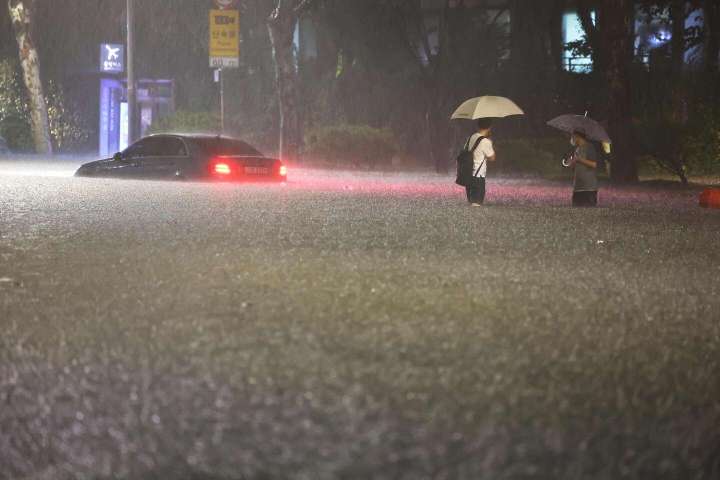SEOUL — At least eight people have died after record rainfall fell over South Korea on Monday and Tuesday, including the capital, Seoul, inundating city streets and flooding subway stations.
At least 8 dead in Seoul-area flooding amid record rainfall

Yoon was getting briefed about the rain and giving instructions remotely overnight from his high-rise apartment, which was partly flooded on the ground level, according to his office.
“Nothing is more precious than life and safety. The government will thoroughly manage the heavy rain situation with the central disaster safety measures headquarters,” Yoon wrote in a Facebook post Monday.
In the nearby Gangnam district, a widely shared image showed a man in a suit sitting atop a submerged car in the upscale neighborhood.
Seoul and other parts of South Korea are currently experiencing torrential downpours.
Dorimcheon stream in Seoul’s Gwanak District has flooded all over, evacuation notice just issued for people living nearby.
Crazy scenes in many other places.pic.twitter.com/EafcXpvvBB
— Raphael Rashid (@koryodynasty) August 8, 2022
The record rainfall — which had not ended as of Tuesday afternoon local time — was the worst in some parts of Seoul since 1904, the year officials began documenting precipitation. About 15 inches (381.5 millimeters) of rain hit southwestern Seoul on Monday, according to the Korea Meteorological Administration. The next-highest rainfall day was Aug. 2, 1920, when 14 inches (354.7 millimeters) fell in Seoul.
The weather agency said an additional 12 to 14 inches of rain is expected through Thursday.
On Tuesday, Yoon visited basement apartments in the Gwanak district of southern Seoul, including one where a 13-year-old and two adults had drowned. Basement homes, where many of Seoul’s poorest residents live, exist throughout the city. He pointed out how “the marginalized groups in the society are even more vulnerable to disasters,” and called for improvement of residential areas with poor safety, according to his spokeswoman.
In southern Seoul’s Dongjak district, a public worker who was clearing debris died in a suspected electrocution, according to the Interior and Safety Ministry. Two people were found dead under the rubble of a bus stop in the southern city of Gwangju.
Blackouts hit some parts of the city, and residents living in lower areas were told to evacuate.
The Korea Meteorological Administration issued downpour alerts through Monday night across central regions, warning that some areas would see 2 to 4 inches (50 to 100 millimeters) of rain per hour. It also sent out heat advisories across eastern South Korean provinces.
These intense precipitation events around the world are increasing because of human-caused climate change, scientists say. A warmer atmosphere is able to hold more moisture and produce heavier rainfall.
CRAZY flooding in Seoul/Gyeonggi right now. Over six feet above normal levels at 안양천…
와 서울이랑 경기에 홍수가 너무 미쳤어요 pic.twitter.com/gSHCrbqmY4
— Joseph (@josephlhatfield) August 8, 2022
Joseph Hatfield, 36, a teacher in Seoul who recorded a video of the flooding in the city of Anyang in Gyeonggi province, south of Seoul, told The Post he saw many people in first-floor units trying to remove water from their homes and businesses.
The torrential rain also slammed North Korea, causing floods and major damage in southern and western parts of the country. Its state-run Rodong Sinmun newspaper reported on Tuesday efforts to prevent damage at construction sites and power plants. Although the state media has not reported on casualties, the country is particularly vulnerable to heavy rain because of deforestation and a lack of resources.
Westfall reported from Washington.






